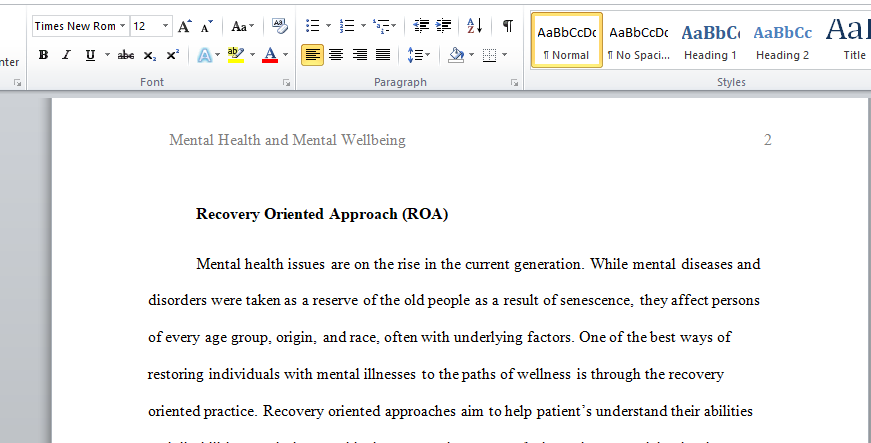Mental health and mental wellbeing for Jennifer, in her late 50s
Mental Health and Mental Wellbeing
Assignment 1 – Case Study
Key Aspects
Firstly, you need to choose one of the three case studies from those provided in this guide
Work to draw on recovery-oriented approach (ROA) principles to mental health social work assessment taught throughout this course
1.Outline your understanding of the core principles of a ROA to assessment in mental health social work.
2. Planning Considerations
Succinctly discuss some of the key planning factors you would need to consider before commencing work with your chosen client; drawing on information taught throughout this course and from your own academic research work in this area (e.g. the importance of mindful case note
reading skills, of the politics of the referral, of good self-reflective practices and so forth).
3. Prioritizing Problems using Key Life Domains Tentative Intervention Plan
Prioritize all of the problems/concerns outlined in your chosen case study notes. Please see the ‘Prioritizing Guidelines’ document on the course website for this section
e.g. best practice approaches when working with young people, when working with people presenting with complex abusive backgrounds
and/or homelessness, with a first experience of panic attacks, into the significant impact of stigma and discrimination, and so forth.
4. Social Work Theories/Models of Practice
Succinctly outline key features of two social work theories/models of practice that could guide your approach to assessment and working with your chosen client and their families. e.g. Feminist theory, Crisis Intervention, Bronfenbrenner’s Ecological Systems Theory, Anti-Oppressive Practice, and Trauma Informed practices.
Outline the reasons these theories/practice models could be helpful
Give examples of how they could be applied in practice to aspects from your chosen cs scenario
5. Ethical and Legal Implications
Briefly discuss key ethical and legal factors that would need to be taken into account, and why?
Remember to link these discussions with specific aspects of your chosen case study scenario.
Jennifer is in her late 50s. She is the fifth child in a family of six. Her father was a labourer and her mother was not in the paid work force. She missed a lot of school because her mother was not well – she now believes her mother struggled with poor mental health and alludes to ongoing domestic violence from her father. Jennifer was an extremely shy child and rarely had friends over to play with. She said she was not particularly close to any of
her siblings, saying that they saw her as ‘weak’ and ‘unstable’ like her mother. Jennifer was also often singled out for physical and emotional abuse at the hands of her father, who called her ‘stupid’ and ‘away with the fairies’. During this time she often blamed her mother for not protecting her and for not making the home a happier one.
Jennifer says that because she felt so unloved in her family, she married young, yearning for this love. She wanted to escape her family and fill the void she experienced in her own childhood. She had three children soon after. Again, Jennifer thought that she could make the loving family she missed out on. Her husband George was about 20 years her senior. He had very strong expectations about marriage and gender divisions within their
relationship. He did not want Jennifer to work outside the family home but to tend to household chores, to cook and look after him and their three children. He was the decision- maker and Jennifer had to do as she was told. Although Jennifer was originally looking for love, care and support, her husband was cold, controlling and emotionally and physically abusive. Over time, Jennifer progressively became very anxious, distressed and eventually had a nervous breakdown.
During this time Jennifer often forgot to pick up the older children from school. She also started to leave her younger children at home and go wandering during the day. When Jennifer went wandering, she would also sometimes become a bit disoriented and forget how to get home. On one occasion the police picked up Jennifer in her disoriented state and took her to Glenside Hospital. At first she was detained for several days under the Mental Health Act, which was then extended a number of times. During this period in Jennifer’s life she was diagnosed with schizophrenia and put on anti-psychotic drugs. Eventually, she was released and allowed to return home. However, upon returning home Jennifer’s husband kicked her out with nowhere to go. This is when Jennifer started living on the streets.
As a homeless person for many years, Jennifer was in and out of homeless shelters continuously. But, more often than not, she roughed it out-doors on the streets. She had a few more involuntary admissions to Glenside under the Mental Health Act over these years but otherwise was able to survive on her own living on the streets. Since living on and off the streets for so long Jennifer unfortunately lost touch with her children, now all adults. She does not know if they are now married or if they have any children of their own. Jennifer has also not kept in contact with any members of her Family of Origin. She doesn’t even know if her parents are still alive, whether any of her siblings have families of their own or where they are living now.
Jennifer has been referred by a women's centre to a supported community housing program. The vision is to offer Jennifer a unit of her own and to implement continual supervision and support.
Answer preview:

Words: 2,680
